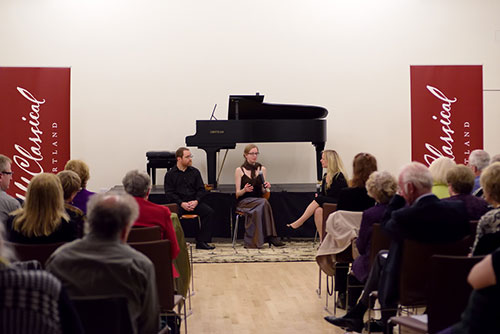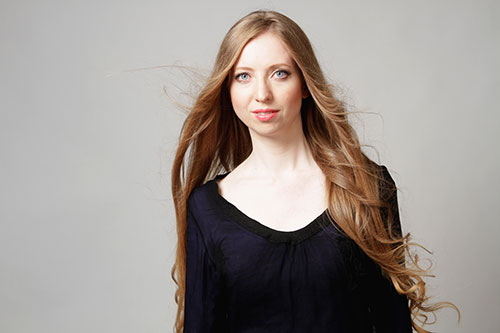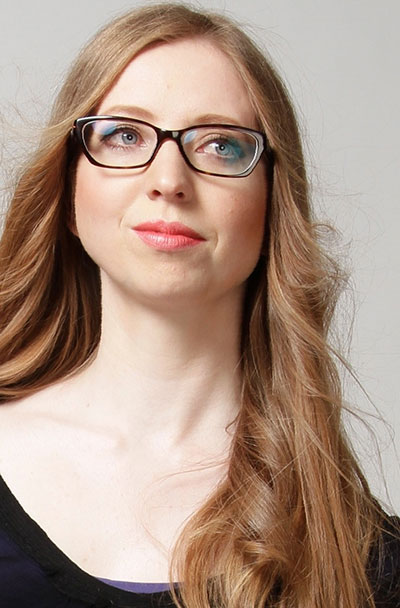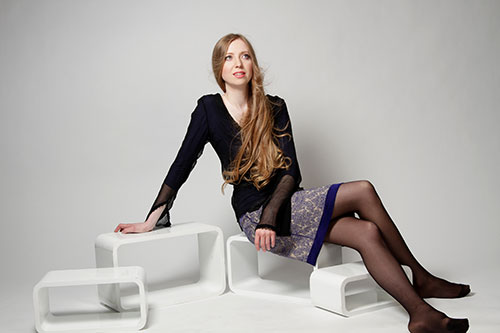

By Lenny Cavallaro
Methuen, MA, USA
"Prelude" from Grieg's Holberg Suite
played on a Bluthner piano (1878)
I like to think of music as sculptures of sound. Sound, being this wonderful, flexible material, unfolds in pitches, chords, dynamics, and textures – never static, but ever-changing and ever-interacting with the listener's feelings. As a musician, my assignment is to mold the sound into something meaningful and share my musical imagination with the listener. – Christina Kobb
I first encountered Christina Kobb through a fascinating article in The New York Times and very much enjoyed her related YouTube presentation. We chatted shortly after her visit to the Yale Collection of Musical Instruments, and I was anxious to learn about her recent tour of the USA and a broad spectrum of piano-related topics.

Christina Kobb and violinist Greg Ewer
with All Classical Portland host Brandi Parisi (November 2015)
(Courtesy of KQAC – All Classical Portland)
LENNY CAVALLARO: Let's start with your three-week tour of the US.
CHRISTINA KOBB: This became a sort of "US Introduction Tour," which developed out of the Times interview. I received an invitation from KQAC – All Classical Portland, an Oregon radio station that streams worldwide, to come for three days to play on the station, give a solo recital, and present a lecture on piano technique. I was flattered, of course, but I couldn't travel across nine time zones for a three-day engagement, so I began to seek other appearances as well. Cornell University, where I studied during 2009/10, welcomed me for a five-day visit, and after Portland I went south to the Ira F. Brilliant Center for Beethoven Studies at San Jose State University, where I lectured on early nineteenth-century piano technique and gave a master class for the students of Dr. Gwendolyn Mok. I also had smaller concerts in churches and private homes, along with several interviews, and I visited San Francisco, New York, North Carolina (Duke), and Connecticut (Yale). In New York, I stayed at soprano Lauren Flanigan's Music & Mentoring House and was invited to make a spontaneous appearance at one of her concerts. People everywhere were very enthusiastic and pleasant, and I got to play on some wonderful historical instruments along the way.
LENNY CAVALLARO: What has been the response to the Times piece, and where will you go from here with your "Mozart" technique?
CHRISTINA KOBB: First of all, I want to explain that the headline with Mozart's name was not my idea! In fact, I was unaware of it until I saw the article published. I have tried out the technique on some of Mozart's music, but what I've really studied is the Viennese technique of the 1820s, based on treatises by Johann Nepomuk Hummel (1778-1837) [a student of Mozart – and later Salieri! – ed.] and his contemporaries. However, a newspaper article is not a musicological treatise, so I do understand that Mozart makes a better headline than Hummel does – especially next to aliens and dinosaurs in the science section! The response to my YouTube video indicates that people are appreciative when performers are able to explain something concrete about their practice. Thus, when I visit places, I find it ideal to give both a concert and a lecture or a seminar. It's great to connect with the audience both intellectually and emotionally.
Regarding the response, I've been amazed by the number of positive reactions to both the article and the video to which it linked. Some came from piano teachers and people interested in early music; these were generally nice and in some ways expected. Perhaps more interesting were comments on YouTube and other forums where people wrote things like, "I'm not a musician, but I enjoyed your video." I was surprised, because I produced the DVD as a supplement to my dissertation – i.e., as part of a Ph.D. project. Thus, I was intrigued by the interest it generated from the "general audience." After all, it was a "nerdy," specialized video intended for my doctoral committee. Moreover, I had all kinds of problems and stress during the recording session, including a lost tuning hammer, which is why the intonation slipped. I kept reassuring myself that at most only ten people would ever watch the final result.

Christina Kobb
LENNY CAVALLARO: How wrong you were, and what a wonderfully gratifying result. If even the people who are not musicians liked it, you truly said something unique and reached a large audience.
CHRISTINA KOBB: It seems I did, and my impression is that many people watched the video simply to gain understanding about how one plays the piano. This might have been the unintended appeal to the general audience, who might find it mysterious how pianists can "cope with all the notes" and organize their bodies to master an instrument. Others enjoyed the information about early pianos and/or Hummel's etudes, which are rarely performed. I suspect some appreciated the fact that a Times Science section piece was not about astrophysics or quantum mechanics, but about something they could relate to.
LENNY CAVALLARO: I'm sure people liked watching a video that articulated these concepts so clearly. The thing I find interesting is that all too often, non-musicians seem especially anxious to sit somewhere in the hall from which location they can look at the pianist's hands. I was impressed by what you explained, and I thought the way you demonstrated the types of position required for a specific technique was truly fascinating and had genuine video appeal as well.
That said, however, let's return to the somewhat misleading title of that article, "Playing Mozart's Piano Pieces as Mozart Did." As you've explained, your primary research interest is actually the 1820s. I must confess I had somehow assumed that most of your work would involve the music of Mozart, Haydn, early Beethoven, and perhaps even Clementi. [Kobb is a past winner of the Muzio Clementi Award – ed.]
CHRISTINA KOBB: That was a logical assumption. Fortepianists typically focus on Haydn, Mozart, and Beethoven, along with their lesser-known contemporaries. I love that repertoire, too, especially Haydn, but I think so much has already been done with that period by great musicians. Moreover, my repertoire springs out of my research, and there is noticeably less scholarship devoted to music following the Haydn to early-Beethoven period. This was already my consideration when I settled on the "post Mozart era" for my doctoral dissertation. The first decades of the nineteenth century are quite exciting, as the piano developed into a mature, stable instrument, and piano composers flourished. However, since recordings weren't yet possible, we're bound to rely largely on written sources when imagining the sound and performance. This is such a rich time for the piano literature. Everything I've done with basic technique and studies of eighteenth-century music theory provides an excellent basis on which to anchor my performances of the entire romantic era.

1826 Graf piano
Chopin's "Black Key" Etude on the Graf (1820s)
LENNY CAVALLARO: I must ask an obvious question, since we have certainly the rise of the "purists," who feel baroque and even early classical music should be played only on period instruments. Do you insist on performing early romantic repertoire on pianos from that era, or are we close enough to the modern instrument that it doesn't matter too much?
CHRISTINA KOBB: Nineteenth-century music performed on nineteenth-century pianos – and employing nineteenth-century piano technique – is truly unique. It brings forth aspects of beauty that are difficult to create in any other way. One hears individual voices more clearly, even in the deeper registers, and the overtones ring in a different way compared to modern instruments. I love the nuances of phrasing and tone. Nevertheless, the practical and financial challenges involved in providing a nice nineteenth-century piano obliges me to play some concerts on a modern grand. At the moment, I'm experimenting with how far I can employ nineteenth-century piano technique on the modern instrument.
LENNY CAVALLARO: Many years ago, quite by accident, I picked up a recording of Rachmaninoff playing Schumann's Carnival. I shall never forget the experience of listening to his absolutely magnificent performance – notwithstanding the dreadful audio quality – and recognizing the depth of his interpretation. I don't believe pianists today have that sort of conception, which, after all, is so much closer to the romantic tradition in which the music was composed. I wonder whether this was because he was directly tied, through his training, to nineteenth-century performance practice. Have you discovered any musicological developments along these lines? If so, where do you see this going?
CHRISTINA KOBB: Oh, it is absolutely true that early recordings, which are now so readily available, challenge what we thought we knew about performance practice and score reading in a particular way. For the earlier periods, we could always fight over what the written documents mean in terms of sound, but with romantic music, the recordings are "sounding proofs." Rachmaninoff's interpretation undeniably represents a tradition much closer to the time when the piece was written. The problem – which still seems impossible to reconcile with the musicological approaches applied so far – is that by studying the score, we would never have guessed Rachmaninoff's rendition of Schumann's Carnival. We get confused, or at least challenged, since the old recordings sound so different from what we thought the musical notation read. While we all agree that Rachmaninoff was a great pianist, I don't think anyone today could get away with playing that repertoire the way he did. The only plausible explanation for his interpretation is that he understood the music differently. Were his concepts of time, phrase, and pulse somehow different than our own? This remains an enigma and should trigger us both as musicologists and musicians.

Christina Kobb
LENNY CAVALLARO: I suspect that to some extent the period instruments themselves may give us some clues. For example, I might open up a score of something by Schumann – whose sense of rhythm was often a little strange – and see that he indicates ritardando some six or seven times in ten measures. Now, this does not mean what it might mean if a composer wrote that in the early twentieth century, much less today. I wonder whether there were effects Schumann's instrument could elicit technically that the modern piano cannot. Surely the sound decayed differently on that piano than it does on a Steinway or Bösendorfer built within the past thirty years. Thus, the question is whether the old instruments might give us insights into what the composer had in mind when he wrote the music.
CHRISTINA KOBB: That may be true, although I think my own experience offers an instructive caveat. I learned a Schumann sonata – the f-sharp minor – first on a modern piano, and then I started to play it regularly on an Érard instrument from 1853. Well, I caught myself pounding out the treble line for several weeks, because in my "internal" ear, I heard Steinway sounds – from both my own practicing and the recordings to which I had listened – and was subconsciously trying to bring forth that same voicing on the Érard, which simply doesn't have a loud treble. My use of the period piano notwithstanding, I realized I was more "gramophonically" informed than historically informed. I suspect I'm not the only one. The piano is silent until someone pushes down a key. If one plays a period piano with a modern technique, one will make the instrument sound more modern. In my video, I demonstrate how technique influences the tone and phrasing, and I'm sure there is so much more to explore regarding romantic music.
LENNY CAVALLARO: A great point! You "heard" the line that way internally because of your earlier exposure on a modern piano. However, I still wonder what the composer had in mind – not that what the composer had in mind is necessarily the "last word" about the music. Here's a related consideration: Sixty years ago it was rare to find harpsichordists, yet today plenty of harpsichord majors obtain graduate degrees from conservatories and universities, and we've learned so much more about the music. You, yourself, majored in fortepiano [the piano of the classical period, perhaps 1740-1820 – ed.]. Do you think we'll see a similar surge of interest in the romantic piano of perhaps the 1830-1860 vintage?
CHRISTINA KOBB: Well, as you know, we also witnessed a baroque "revival" around fifty years ago, and these days it is not unusual to hear performances on period instruments – even works like the Bach cantatas or passions. Unfortunately, I'm afraid the trend has reversed recently, especially for fortepianos. In fact, I see a diminished interest in the piano generally, and the industry is declining. It seems fewer and fewer people keep pianos, and if they have any interest, it is more likely satisfied through electronic instruments. The piano is in many ways the cornerstone of music education, but there is certainly less emphasis on music in schools and homes these days. It's a complex picture, and I can't say I'm confident that we'll have a major period piano resurgence any time soon – at least not on the scale we saw for harpsichord.
Third of Schubert's Moments Musicaux,
the famous F minor piece
LENNY CAVALLARO: Something you said segues rather naturally to another interest of yours: "fewer and fewer people keep pianos." You've recently set up pages on both LinkedIn and Facebook to promote the idea of "PianoShelters."
CHRISTINA KOBB: I've had enormous response to the Times story and almost 160,000 views on my YouTube video. It occurred to me that pianos must truly mean something to people, beyond their immediate function as instruments. Over the years, as the piano was a fixture in the household, "everyone" had an everyday memory connected to piano playing: recollections of family members who played, memories of particular instruments at relatives' houses, and inevitably, people who seem to look back with some regret and wish they hadn't stopped taking lessons. These personal memories stand in sharp contrast to what we see now. Pianos are removed from classrooms, neglected in hospitals and community centers, and often unceremoniously "dumped" from private homes. It's sad and wasteful, because the piano is such a great resource. I began to realize that pianos connect people – through shared memories. This is another aspect of beauty I miss: the beauty of creating everyday piano memories for everyone, and of making music on any level, just for the pleasure and company.
PianoShelters is an idea I am promoting to make this happen again, but it will require many people to bring the concept to fruition. I am more than happy to contribute advice, ideas, and moral support to those who want to establish a PianoShelter within their organization, church, or the like, but it is far too large an undertaking for one person. I encourage other people to build on the idea, and maybe in the future we'll see a more formal organization.

Christina Kobb
LENNY CAVALLARO: And you're still working on your dissertation. Are your performances related to your doctoral work?
CHRISTINA KOBB: My degree will be a Ph.D., not a D.M.A. (Doctor of Musical Arts). However, I've chosen an area within the discipline that is closely related to my playing. In a sense, then, I'll be able to do both – musicology and performance. I plan to finish fairly soon. I was appointed head of theory at Barratt Due Institute of Music in Oslo in 2013, but I've taken a leave of absence this year to complete the dissertation. Nevertheless, the experience of teaching music theory, music history, and analysis is a good base when preparing lectures as well as concerts for any audience.
LENNY CAVALLARO: Best of fortune with the dissertation and your numerous ventures!
Links:
Lenny Cavallaro at Stay Thirsty Publishing
Lenny Cavallaro - Composer and Pianist
Lenny Cavallaro at Broadbent & Dunn Ltd.





